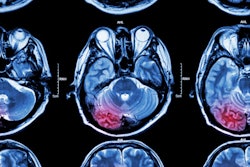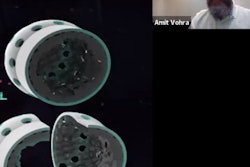
In a world dominated by high-field MRI -- including superpowerful 7-tesla scanners ‑‑ is there still a role for very-low-field MRI technology? Maybe, according to presentations at the International Society for Magnetic Resonance Imaging in Medicine (ISMRM) virtual meeting.
The early days of MRI saw a split into two camps, between those who sought out the exquisite resolution of superconducting high-field magnets and those who saw the potential of more-flexible systems based on nonsuperconducting magnets at lower field strengths. But as MRI developed, high-field scanning won out: Magnets operating at 1.5 tesla and 3 tesla dominate the field.
But what if very-low-field MRI had been allowed to develop? MRI pioneer Raimo Sepponen, PhD, of Aalto University in Finland pondered what might have been in an ISMRM talk that included a historical overview of low-cost scanning.
Sepponen noted that in the early days of MRI, some actually thought that the modality would replace x-rays, that no contrast agents would be needed, that at higher field strengths tissue contrast would be lost with MRI, and that the specific absorption rate would be a limiting factor of higher-field MRI.
"All these beliefs were proven to be false," he said
Seponnen discussed the effort to develop a 20 millitesla (mtesla) MRI scanner for emergency and trauma imaging. There were possible advantages to 20 mtesla MRI, such as low initial costs and high contrast that enabled differentiation between free water and normal tissue. But the downside was that 20 mtesla had a low signal-to-noise ratio, Sepponen said.
Still, very-low-field MRI was thought to offer utility even if it did not have a broad base of applications. One of these applications was in diagnosing internal hemorrhage as a result of blunt trauma. While saline injected into the abdomen had been generally used to diagnose if hemorrhaging had occurred and to determine if surgery was required, this technique was not able to diagnose if there had been hemorrhaging in the liver or spleen.
Sepponen noted that very-low-field MRI could play a role in that regard and that MRI units had the potential to be found in emergency departments, where they could be used for acute situations like blunt trauma.
AcutScan was one of the very first very-low-field MRI units, developed in the 1980s in Finland. Operating at 20 mtesla, the system had major limitations.
"The computer system was not very resourceful and limited the capability of introducing new improved imaging sequences, as well as methods for image processing," Sepponen recalled.
However, low-field MRI was useful in some acute cases of brain contusions and hemorrhages, he said.
"It proved to be useful in many neurological conditions, especially in the diagnosis of small tumors, infarcts, and multiple sclerosis," Sepponen said. "It was superior to the existing methods of the time."
Diagnosing lung conditions is also a good application for MRI units with low field strengths, Sepponen said.
"The diagnosis of lung diseases has not been a strong application of [standard] MRI," he said. "Differentiating between lung and air tissues is not a problem with low-field MRI."
Still another diagnostic benefit of very-low-field MRI has been in diagnosing liver lesions. A multiple-slice spin lock imaging technique with very-low-field MRI was able to distinguish hemangiomas from metastatic liver lesions, Sepponen noted.
While dozens of very-low-field MRI scanners were operating in Europe, the Soviet Union, Japan, and the U.S. in the 1980s, demand for MRI scanners at higher field strengths emerged. Soon, conventional wisdom was that very-low-field MRI did not have sufficient field strength, he explained.
Renewed interest
But there is renewed interest in very-low-field MRI, according to Sepponen. Indeed, new magnet designs that place scanners on portable carts that can be wheeled to a patient's bedside are becoming available.
In a presentation in the same session, Shaoying Huang, PhD, of Singapore University of Technology and Design discussed the utility of very-low-field MRI in rural and underdeveloped areas. Low-field MRI has advantages in terms of sitting space, energy consumption, and cost, she said.
Huang discussed how research has been presented at past ISMRM conferences on alternative MRI designs, such as dedicated superconducting scanners for brain and torso imaging. Electromagnetic MRI designs also have some potential, in terms of lower power consumption and cost. A four-coil biplanar magnet design for head imaging has been proposed with a 20-cm field of view at 6.5 mtesla.
With permanent magnet designs, there is little power consumption and no need for a cooling system. Commercial designs of this sort have been introduced, such as a C-shaped magnet at 0.35 tesla for full-body scanning. Dedicated permanent magnet systems are also possible for applications like knee and ankle scanning. Systems operating at 0.3 tesla and 0.15 tesla are in operation, Huang noted.
Finally, Huang discussed research into scanners using Halbach ring arrays -- a type of permanent magnet array -- formed into a tunnel and designed to provide single-sided scanning for portable applications. Other types of very-low-field designs are also possible.
Research of the type described by Huang and Sepponen raises the possibility that the debates of the early years of MRI could be renewed.
"We may expect new opportunities in the future," Sepponen said.



.fFmgij6Hin.png?auto=compress%2Cformat&fit=crop&h=100&q=70&w=100)




.fFmgij6Hin.png?auto=compress%2Cformat&fit=crop&h=167&q=70&w=250)











